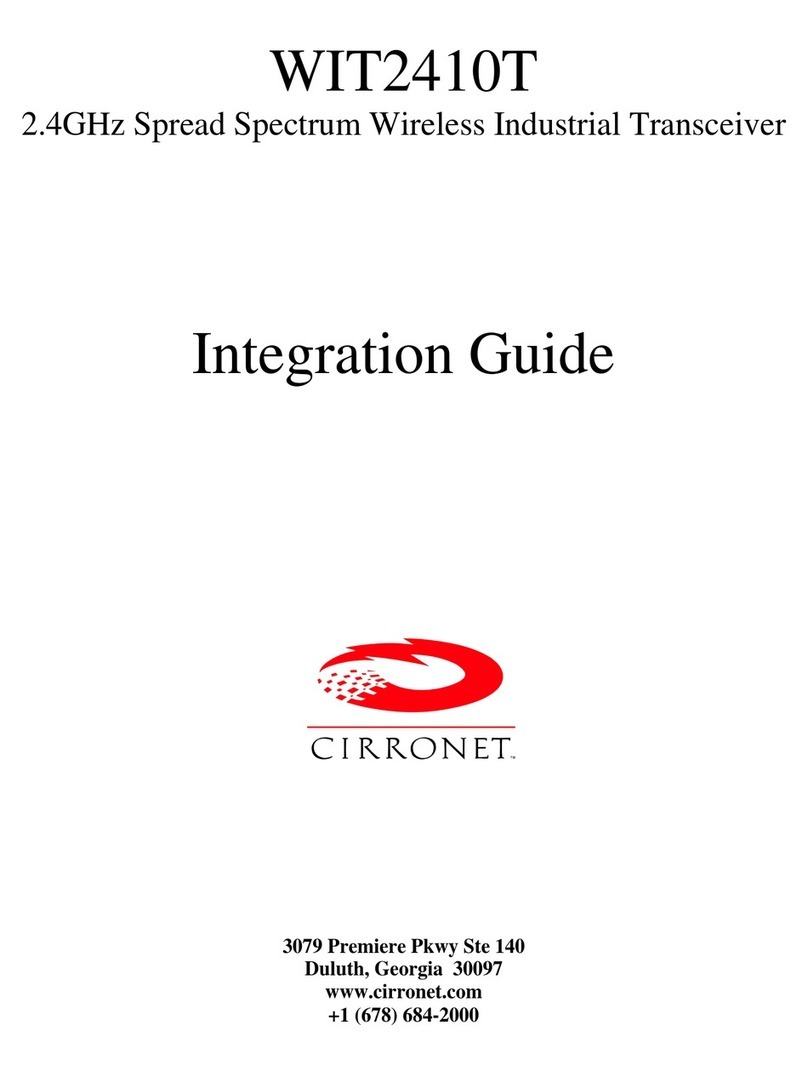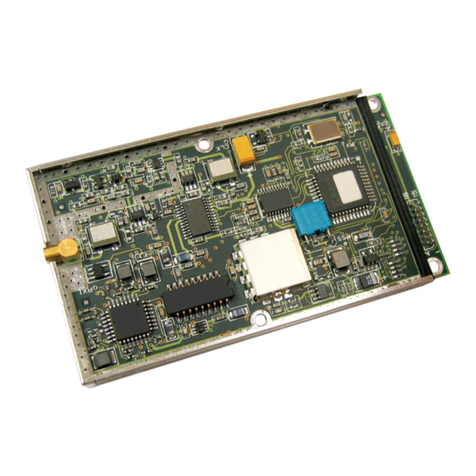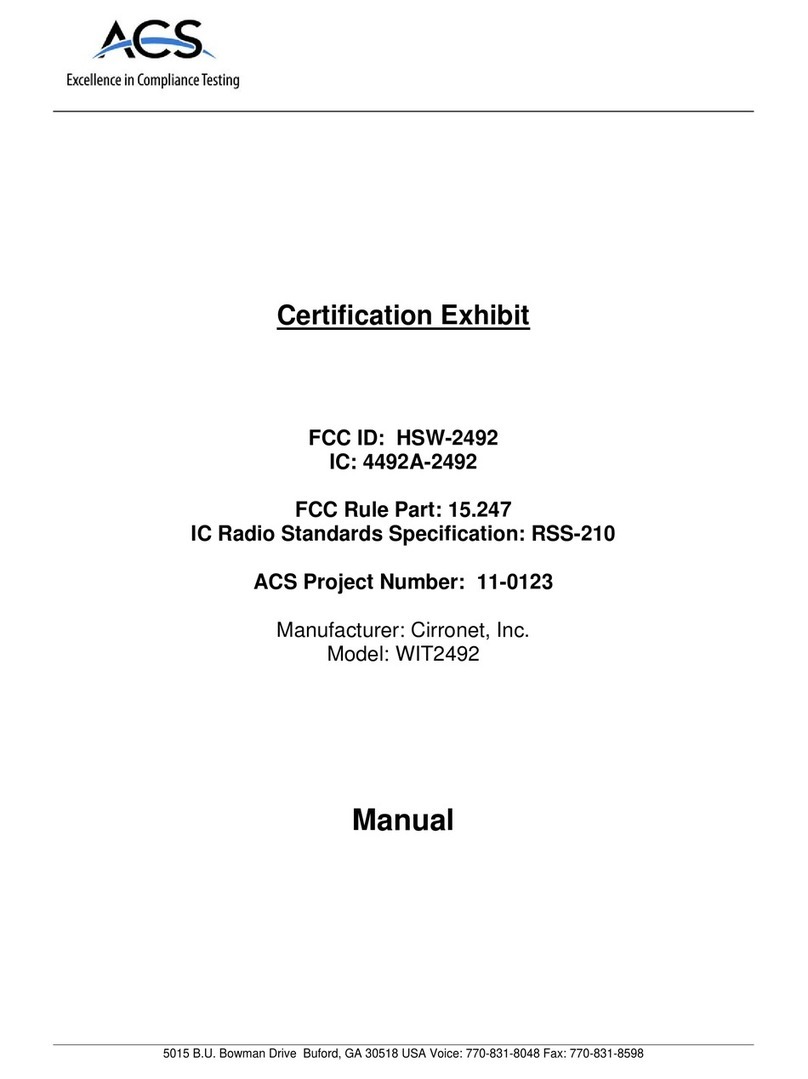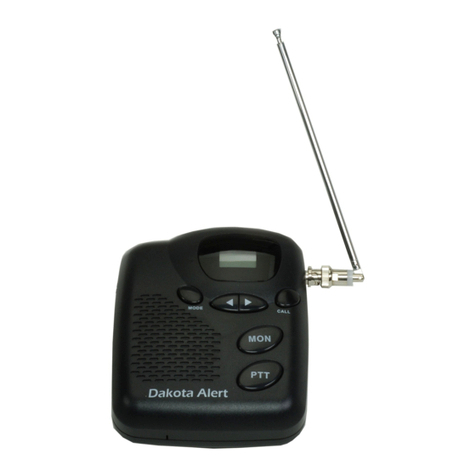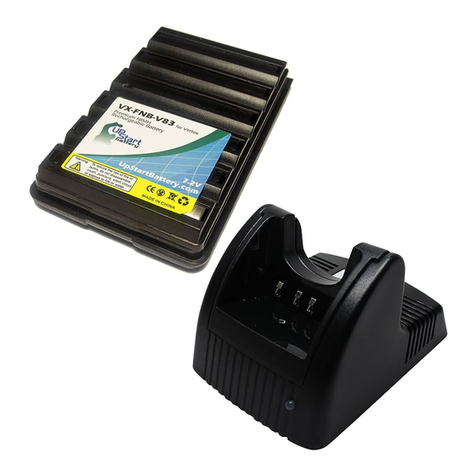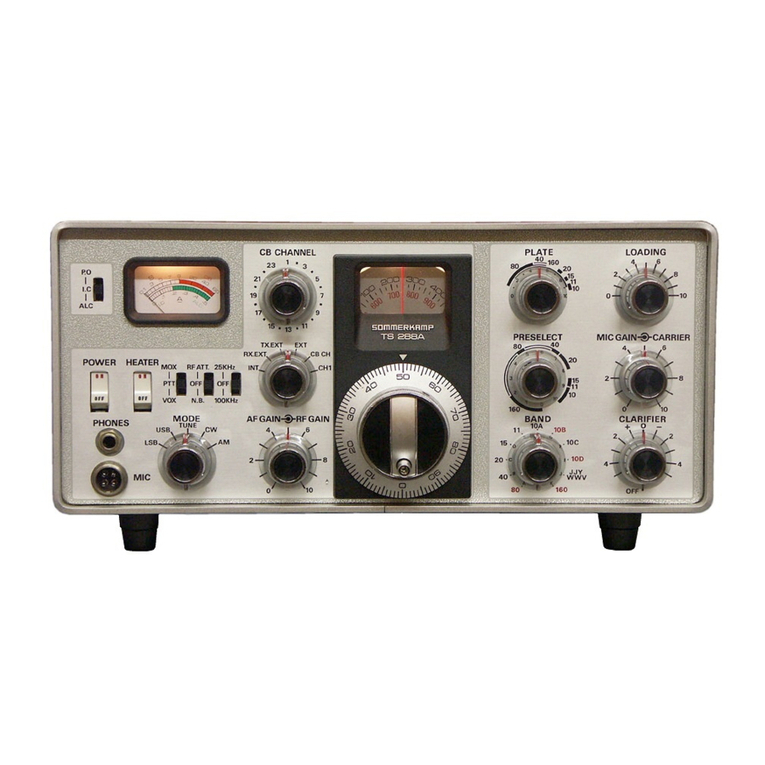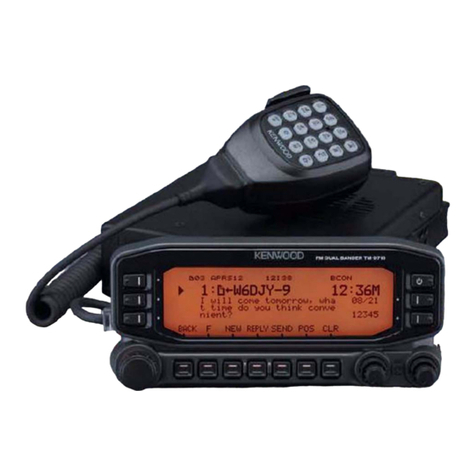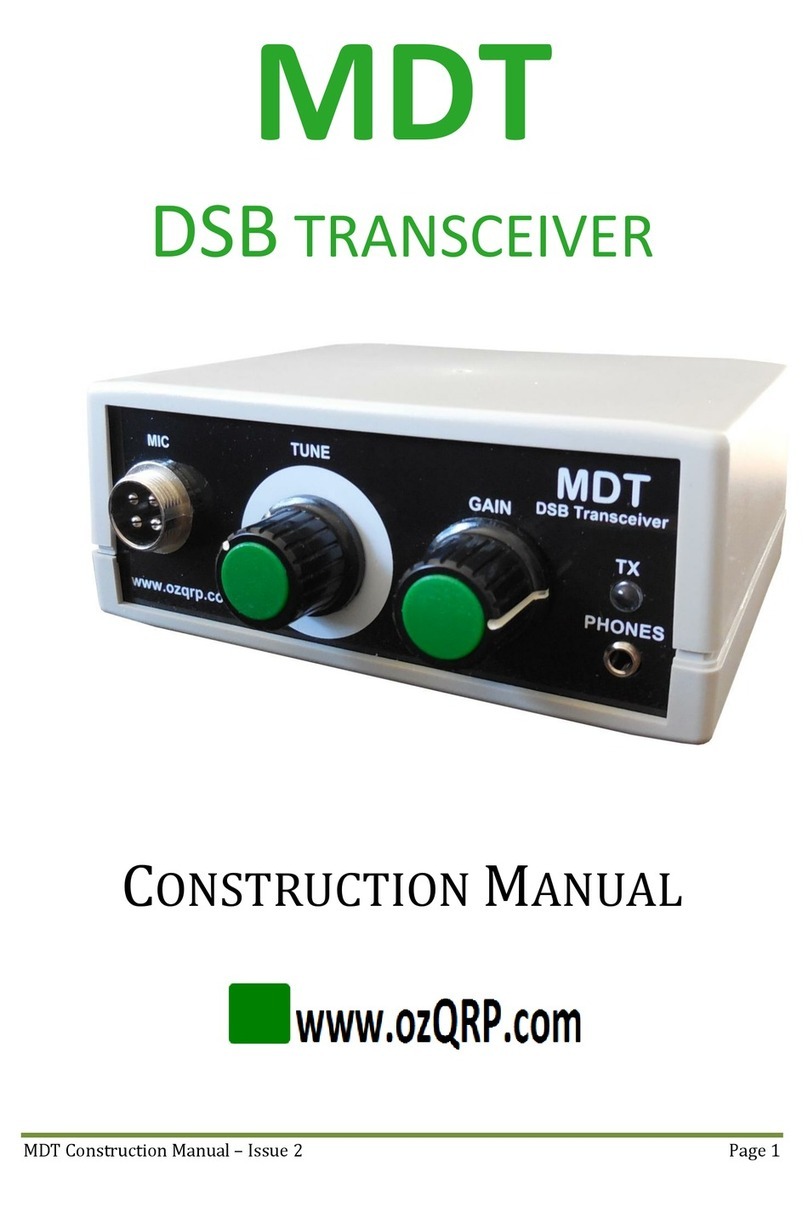Cirronet WIT 2550 Quick setup guide

WIT2450
2.4GHz Spread Spectrum Wireless Industrial Transceiver
Integration Guide
3079 Premiere Pky Ste 140
Duluth, Georgia 30097
www.cirronet.com
+1 (678) 684-2000

Important Regulatory Information
Cirronet Product FCC ID: HSW-2450
IC 4492A-2450
FCC s MPE Requirements
Information to user/installer regarding FCC s Maximum Permissible Exposure (MPE) limits.
Notice to users/installers using the 24 dBi parabolic dish antenna in conjunction with all Cirronet
RF products.
FCC rules limit the use of this antenna, when connected to Cirronet RF products for point-to-point
applications only. It is the responsibility of the installer to ensure that the system is prohibited from
being used in point-to-multipoint applications, omni-directional applications, and applications where there
are multiple co-located intentional radiators transmitting the same information. Any other mode of
operation using this antenna is forbidden.
Notice to users/installers using the following fixed antennas, with Cirronet RF products:
Andrews 24dBi parabolic dish
Andrews 18dBi parabolic dish
Cushcraft 15dBi Yagi,
Mobile Mark 14dBi Corner Reflector,
Mobile Mark 9dBi Corner Reflector
The field strength radiated by any one of these
antennas, when connected to Cirronet RF
products, may exceed FCC mandated RF
exposure limits. FCC rules require
professional installation of these antennas in
such a way that the general public will not be
closer than 2 m from the radiating aperture of
any of these antennas. End users of these
systems must also be informed that RF
exposure limits may be exceeded if personnel
come closer than 2 m to the apertures of any of
these antennas.
Notice to users/installers using the following mobile antennas, with Cirronet RF products:
Mobile Mark 12dBi omni-directional,
Mobile Mark 9dBi omni-directional,
MaxRad 5dBi whip,
Cirronet Patch antenna,
Ace 2dBi dipole,
Mobile Mark 2dBi Stub
The field strength radiated by any one of these
antennas, when connected to Cirronet RF
products, may exceed FCC mandated RF
exposure limits. FCC rules require
professional installation of these antennas in
such a way that the general public will not be
closer than 20 cm from the radiating aperture
of any of these antennas. End users of these
systems must also be informed that RF
exposure limits may be exceeded if personnel
come closer than 20 cm to the apertures of any
of these antennas.
Note: This unit has been tested and found to comply with the limits for a Class A digital device,
pursuant to part 15 of the FCC Rules. These limits are designed to provide reasonable protection
against harmful interference when the equipment is operated in a commercial environment. This
equipment generates, uses, and can radiate radio frequency energy and, if not installed and used
in accordance with the instruction manual, may cause harmful interference to radio
communications. Operation of this equipment in a residential area is likely to cause harmful
interference in which case the user will be required to correct the interference at their expense.

Declaration of Conformity
Warning! The RLAN transceiver within this device uses a band of frequencies that are not completely harmonized
within the European Community. Before using, please read the European Operation Section of the Products User’s
Guide for limitations.
0889 is the identification number of RADIO FREQUENCY INVESTIGATION LTD - Ewhurst Park, Ramsdell RG26
5RQ Basingstoke, United Kingdom – the Notified Body having performed part or all of the conformity assessment on
the product.
The WIT2450 to which this declaration relates is in conformity with the essential requirements of the R&TTE
directive 1999/5/EC and complies with the following standards and/or other normative documents:
For Interfaces For RLAN Transceiver
EN 55022
EN 55024 EN 300 328
EN 301 489 -1, -17
EN 60950
Use Within the European Union
The WIT2450 is intended for use within the European Community States and in the following non-European Union
States: Norway & Switzerland
Use of the WIT2450 in France
When used in France, the WIT2410 can only be operated with the France hopping pattern selected. This is
accomplished by setting the pe parameter to 6. Refer to European Union Settings in this manual for details.
Canadian Department of Communications Industry Canada (IC) Notice
Canadian Department of Communications Industry Canada (IC) Notice
This apparatus complies with Health Canada’s Safety Code 6 / IC RSS 102.
"To prevent radio interference to the licensed service, this device is intended to be
operated indoors and away from windows to provide maximum shielding. Equipment (or
its transmit antenna) that is installed outdoors may be subject to licensing."
ICES-003
This digital apparatus does not exceed the Class B limits for radio noise emissions from
digital apparatus as set out in the radio interference regulations of Industry Canada.
Le présent appareil numérique n'émet pas de bruits radioélectriques dépassant les limites applicables aux appareils
numériques de Classe B prescrites dans le règlement sur le brouillage radioélectrique édicté par Industrie Canada.

TABLE OF CONTENTS
1. INTRODUCTION ......................................................................................................................6
1.1. Why Spread Spectrum? .......................................................................................................7
1.2. Frequency Hopping vs. Direct Sequence.............................................................................8
2. RADIO OPERATION..............................................................................................................10
2.1. Synchronization and Registration......................................................................................10
2.2. Data Transmission .............................................................................................................11
2.2.1. Point-to-Point...........................................................................................................11
2.2.2. Point-to-Multipoint ..................................................................................................12
2.2.3. Full Duplex Communication....................................................................................12
2.2.4. Channel Access........................................................................................................12
2.2.5. Store and Forward Repeater Operation....................................................................18
2.3. Modes of Operation ...........................................................................................................21
2.3.1. Control and Data Modes ..........................................................................................21
2.3.2. Power Down Mode ..................................................................................................22
2.3.3. RF Flow Control Mode............................................................................................22
2.3.4. Co-Existing with 802.11b Networks........................................................................23
2.3.5. European Union Settings .........................................................................................23
3. PROTOCOL MODES ..............................................................................................................24
3.1.1. Data Packet...............................................................................................................25
4. MODEM INTERFACE............................................................................................................26
4.1. Interfacing to 5-Volt Systems............................................................................................27
4.2. Evaluation Unit and OEM Module Differences ................................................................27
4.3. Three Wire Operation........................................................................................................27
4.4. Power-On Reset Requirements..........................................................................................28
4.6. Received Signal Strength Indicator ...................................................................................29
5. MODEM COMMANDS...........................................................................................................30
5.1. Serial Commands...............................................................................................................31
5.2. Network Commands ..........................................................................................................34
5.3. Protocol Commands...........................................................................................................37
5.4. Status Commands ..............................................................................................................40
5.5. Memory Commands ..........................................................................................................41
5.6. Modem Command Summary.............................................................................................42
6. WIT2450 DEVELOPER’S KIT ...............................................................................................43
7.0 WinCOM.................................................................................................................................44
7.1 Starting the program ...........................................................................................................46
7.2 Function Keys.....................................................................................................................49
7.3 WinCom Tools....................................................................................................................50
7.4 Script Commands................................................................................................................53
7.5 Demonstration Procedure ...................................................................................................56

8. STORE AND FORWARD REPEATER OPERATION ..........Error! Bookmark not defined.
9. TROUBLESHOOTING............................................................................................................57
10. APPENDICES ........................................................................................................................59
10.1. Technical Specifications..................................................................................................59
10.1.1. Ordering Information.............................................................................................59
10.1.2. Power Specifications..............................................................................................59
10.1.3. RF Specifications...................................................................................................59
10.1.4. Mechanical Specifications .....................................................................................59
10.2. Serial Connector Pinouts .................................................................................................60
10.3. Approved Antennas .........................................................................................................60
10.4. Technical Support............................................................................................................61
10.5. Reference Design.............................................................................................................62
10.6. Mechanical Drawing – WIT2450....................................................................................63
11. WARRANTY .........................................................................................................................64
Conventions:
All Hexadecimal Numbers are written in New Courier font, 10 pt Bold as shown here: 30H

WIT2450
©2000- 2005 Cirronet™Inc 6 M-2450-0000 Rev B
1. INTRODUCTION
From the leader in robust, high-performance wireless modules comes the next generation
of low-cost 2.4GHz spread spectrum OEM modules. The Cirronet WIT2450 provides the
unique combination of highly integrated low-cost components with Cirronet’s high
performance, high-reliability RF know-how that has made Cirronet products the first
choice of designers for mission critical applications. With the WIT2450, designers get
that same mission critical reliability and robustness but at a price that allows use in a
wide variety of cost-sensitive applications.
The WIT2450 radio transceiver provides reliable wireless connectivity for either
point-to-point or multipoint applications. Frequency hopping spread spectrum
technology ensures maximum resistance to noise and multipath fading and robustness in
the presence of interfering signals, while operation in the 2.4GHz ISM band allows
license-free use and worldwide compliance. A simple serial interface supports
asynchronous data up to 230400 bps. An on-board 1 KB buffer and an error-correcting
over-the-air protocol provide smooth data flow and simplify the task of integration with
existing applications.
•Multipath fading
impervious frequency
hopping technology with
86 frequency channels.
•Meets FCC rules 15.247
and ETS 300.328 for
worldwide license-free
operation.
•Supports point-to-point or
point to multipoint
applications.
•Simple serial interface
handles both data and
control at up to 230.4kbps.
•Low power 3.3v CMOS
signals •Selectable 10 mW, 63mW
or 250 mW transmit
power.
•Superior range to 802.11
wireless Local Area
Network devices.
•CSMA or Dynamic
TDMA slot assignment
that maximizes throughput.
•Transparent ARQ protocol
w/512 byte buffer ensures
data integrity.
•Built-in data scrambling
reduces possibility of
eavesdropping.
•Digital addressing supports
up to 64 networks, with 62
remotes per network.
•Nonvolatile memory stores
configuration when
powered off.
•Fast acquisition typically
locks to hopping pattern in
2 seconds or less.
•Smart power management
features for low current
consumption.

WIT2450
©2000- 2005 Cirronet™Inc 7 M-2450-0000 Rev B
1.1. Why Spread Spectrum?
The radio transmission channel is very hostile, corrupted by noise, path loss and
interfering transmissions from other radios. Even in a pure interference-free
environment, radio performance faces serious degradation through a phenomenon
known as multipath fading. Multipath fading results when two or more reflected
rays of the transmitted signal arrive at the receiving antenna with opposing phase,
thereby partially or completely canceling the desired signal. This is a problem
particularly prevalent in indoor installations. In the frequency domain, a multipath
fade can be described as a frequency-selective notch that shifts in location and
intensity over time as reflections change due to motion of the radio or objects within
its range. At any given time, multipath fades will typically occupy 1% - 2% of the
2.4 GHz band. This means that from a probabilistic viewpoint, a conventional radio
system faces a 1% - 2% chance of signal impairment at any given time due to
multipath.
Spread spectrum reduces the vulnerability of a radio system to interference from
both jammers and multipath fading by distributing the transmitted signal over a
larger region of the frequency band than would otherwise be necessary to send the
information. This allows the signal to be reconstructed even though part of it may be
lost or corrupted in transit.
Figure 1
Narrowband vs. spread spectrum in the presence of interference

WIT2450
©2000- 2005 Cirronet™Inc 8 M-2450-0000 Rev B
1.2. Frequency Hopping vs. Direct Sequence
The two primary approaches to spread spectrum are direct sequence (DS) and
frequency hopping (FH), either of which can generally be adapted to a given
application. Direct sequence spread spectrum is produced by multiplying the
transmitted data stream by a much faster, noise-like repeating pattern. The ratio by
which this modulating pattern exceeds the bit rate of the baseband data is called the
processing gain, and is equal to the amount of rejection the system affords against
narrowband interference from multipath and jammers. Transmitting the data signal
as usual, but varying the carrier frequency rapidly according to a pseudo-random
pattern over a broad range of channels produces a frequency hopping spectrum
system.
Figure 2
Forms of spread spectrum
One disadvantage of direct sequence systems is that due to spectrum constraints and
the design difficulties of broadband receivers, they generally employ only a minimal
amount of spreading (typically no more than the minimum required by the regulating
agencies). For this reason, the ability of DS systems to overcome fading and in-band
jammers is relatively weak. By contrast, FH systems are capable of probing the
entire band if necessary to find a channel free of interference. Essentially, this
means that a FH system will degrade gracefully as the channel gets noisier while a
DS system may exhibit uneven coverage or work well until a certain point and then
give out completely.
Because it offers greater immunity to interfering signals, FH is often the preferred
choice for co-located systems. Since direct sequence signals are very wide, they
tend to offer few non-overlapping channels, whereas multiple hoppers may
interleave with less interference. Frequency hopping does carry some disadvantage
in that as the transmitter cycles through the hopping pattern it is nearly certain to
visit a few blocked channels where no data can be sent. If these channels are the
same from trip to trip, they can be memorized and avoided; unfortunately, this is

WIT2450
©2000- 2005 Cirronet™Inc 9 M-2450-0000 Rev B
generally not the case, as it may take several seconds to completely cover the hop
sequence during which time the multipath delay profile may have changed
substantially. To ensure seamless operation throughout these outages, a hopping
radio must be capable of buffering its data until a clear channel can be found. A
second consideration of frequency hopping systems is that they require an initial
acquisition period during which the receiver must lock on to the moving carrier of
the transmitter before any data can be sent, which typically takes several seconds. In
summary, frequency hopping systems generally feature greater coverage and channel
utilization than comparable direct sequence systems. Of course, other
implementation factors such as size, cost, power consumption and ease of
implementation must also be considered before a final radio design choice can be
made.
As an additional benefit, RF spectrum has been set aside at 2.4 GHz in most
countries (including the U.S.) for the purpose of allowing compliant spread spectrum
systems to operate freely without the requirement of a site license. This regulatory
convenience alone has been a large motivation for the industry-wide move toward
spread spectrum.

WIT2450
©2000- 2005 Cirronet™Inc 10 M-2450-0000 Rev B
2. RADIO OPERATION
2.1. Synchronization and Registration
As discussed above, frequency hopping radios periodically change the frequency at
which they transmit. In order for the other radios in the network to receive the
transmission, they must be listening to the frequency over which the current transmission
is being sent. To do this, all the radios in the net must be synchronized and must be set to
the same hopping pattern.
In point-to-point or point-to-multipoint arrangements, one radio module is designated as
the base station. All other radios are designated remotes. One of the responsibilities of
the base station is to transmit a synchronization signal to the remotes to allow them to
synchronize with the base station. Since the remotes know the hopping pattern, once they
are synchronized with the base station, they know which frequency to hop to and when.
Every time the base station hops to a different frequency, it immediately transmits a
synchronizing signal.
When a remote is powered on, it rapidly scans the frequency band for the synchronizing
signal. Since the base station is transmitting over 86 frequencies and the remote is
scanning 86 frequencies, it can take several seconds for a remote to synch up with the
base station.
Once a remote has synchronized with the base station, it must request registration from
the base station. The registration process identifies to the base station the remotes from
which transmissions will be received and not discarded. Registration also allows tracking
of remotes entering and leaving the network. The base station builds a table of serial
numbers of registered remotes.
To detect if a remote has gone offline or out of range, the registration can be “renewed”
once every 256 hops. Registration is completely automatic and requires no user
application intervention. When the remote is registered, it will receive several network
parameters from the base. This allows the base to automatically update these network
parameters in the remotes over the air. Once a parameter has been changed in the base, it
is automatically changed in the remotes. The parameters that are automatically changed
are hop duration and the duty cycle.
At the beginning of each hop, the base station transmits a synchronizing signal. After the
synchronizing signal has been sent, the base will transmit any data in its buffer unless
data transmit delay has been set. The data transmit delay parameter allows for the
transmission of groups of continuous data in transparent mode (protocol mode 00H). The
amount of data that the base station can transmit per hop is determined by the base slot
size parameter. The maximum amount of data sent by a base station per hop is 208 bytes.
If there is no data to be sent, the base station will not transmit until the next frequency.

WIT2450
©2000- 2005 Cirronet™Inc 11 M-2450-0000 Rev B
The operation for remotes is similar to the base station without the synchronizing signal.
The amount of data a remote can send on one hop is dependent upon the hop duration,
the base slot size and the number of registered remotes. 212 bytes per hop is the
maximum data length a remote can transmit per hop, subject to limitations imposed by
the hop duration, the base slot size and the number of registered remotes. A detailed
explanation of this relationship is provided in Section 2.2.3. Minimum data length and
data transmit delay operate the same as with the base station.
Except for the registration process which occurs only when a remote logs onto the
network, the whole procedure is repeated on every frequency hop. Refer to the section
on Modem Commands for complete details on parameters affecting the transmission of
data.
2.2. Data Transmission
The WIT2450 supports two network configurations: point-to-point and point-to-
multipoint. In a point-to-point network, one radio is set up as the base station and the
other radio is set up as a remote. In a point-to-multipoint network, a star topology is used
with the radio set up as a base station acting as the central communications point and all
other radios in the network set up as remotes. In this configuration, all communications
take place between the base station and any one of the remotes. Remotes cannot
communicate directly with each other.
2.2.1. Point-to-Point
In point-to-point mode, unless data transmit delay or minimum data length have been set,
the base station will transmit whatever data is in its buffer limited to 208 bytes or as
limited by the base slot size. If the base station has more data than can be sent on one
hop, the remaining data will be sent on subsequent hops. In addition to the data, the base
station adds some information to the transmission over the RF link. It adds the address of
the remote to which it is transmitting, even though in a point-to-point mode there is only
one remote. It also adds a sequence number to identify the transmission to the remote.
This is needed in the case of acknowledging successful transmissions and retransmitting
unsuccessful transmissions. Also added is a 24-bit CRC to allow the base to check the
received transmission for errors. When the remote receives the transmission, it will
acknowledge the transmission if it was received without errors. If no acknowledgment is
received, the base station will retransmit the same data on the next frequency hop.
In point-to-point mode, a remote will transmit whatever data is in its buffer up to the limit
of its maximum data length. If desired, minimum data length and data transmit delay can
also be set, which force the remote to wait until a certain amount of data is available or
the specified delay is exceeded before transmitting. If the remote has more data than can
be sent on one hop, it will send as much data as possible as a packet, adding its own
address, a packet sequence number and 24-bit CRC. These additional bytes are
transparent to the user application if the protocol mode is 00H (which is the default). In
the event a remote has more data to send, the data will be sent on subsequent hops. If the

WIT2450
©2000- 2005 Cirronet™Inc 12 M-2450-0000 Rev B
transmission is received by the base station without errors, the base station will
acknowledge the transmission. If the remote does not receive an acknowledgment, it will
retransmit the data on the next frequency hop. To the user application, acknowledgments
and retransmissions all take place behind the scenes without the need for user
intervention.
2.2.2. Point-to-Multipoint
In point-to-multipoint mode, data sent from the user application to the base station must
be packetized by the user application unless the remote device can distinguish between
transmissions intended for it and transmissions intended for other remote devices. This is
necessary to identify the remote to which the base station should send data. When the
user packet is received by the remote, if the remote is in transparent mode (protocol mode
0), the packetization bytes are stripped by the remote. In this instance the remote host
receives just data. If the remote is not in transparent mode, the remote host will receive
the appropriate packet header as specified by the remote’s protocol mode. Refer to the
section Protocol Modes for details on the various packet formats.
When a remote sends data to a base station in point-to-multipoint mode, the remote host
does not need to perform any packetization of the data. Remotes can operate in
transparent mode even though the base is operating in a packet mode. The remote will
add address, sequence and CRC bytes as in the point-to-point mode. When the base
station receives the data, the base station will add packetization header bytes according to
its protocol mode setting.
2.2.3. Full Duplex Communication
From an application perspective, the WIT2450 communicates in full duplex. That is,
both the user application and the remote terminal can be transmitting data without
waiting for the other to finish. At the radio level, the base station and remotes do not
actually transmit at the same time. If they did, the transmissions would collide. As
discussed earlier, the base station transmits a synchronization signal at the beginning of
each hop followed by a packet of data. After the base station transmission, the remotes
will transmit. Each base station and remote transmission may be just part of a complete
transmission from the user application or the remote terminal. Thus, from an application
perspective, the radios are communicating in full duplex mode since the base station will
receive data from a remote before completing a transmission to the remote.
2.2.4. Channel Access
The WIT2450 provides two methods of channel access: CSMA or TDMA. Carrier sense
multiple access (CSMA) is either polling or contention based. Time division multiple
access, TDMA, is slotted or scheduled. A more detailed explanation of Time Division
Multiple Access can be found in the section on TDMA. The default access mode is
CSMA and the default setting is wa0. CSMA protocol is very effective at sorting random
packets of irregular data from a large number of remote nodes. The access mode setting is

WIT2450
©2000- 2005 Cirronet™Inc 13 M-2450-0000 Rev B
distributed to all remotes in the base status packet, so changing it at the base affects the
entire network.
CSMA
CSMA is less efficient than TDMA in some circumstances, but has the advantage or
requiring no special coordination between remotes. When using CSMA the remotes
simply listen to see if the channel is clear and then transmit. If the channel is not clear the
remote unit will wait a random period of time and try again. This mode works best when
a large or variable number of remotes transmit infrequent bursts of data or in polling
applications where the host will request data and wait for a response prior to moving to
the next remote. In CSMA mode, there is no limit to the number of remote radios that can
be supported.
The illustration below compares TDMA to CSMA.
wa setting Description max PN remote packet size
0 (default) CSMA polling FFH manual, set by pl
1 CSMA contention
FFH manual, set by pl
2 TDMA auto slots 0FH auto, read from pl
3 TDMA fixed slots 0FH auto, read from pl
4 TDMA override 0FH manual, set by pl
wa setting Description max PN remote packet size
0 (default) CSMA polling FFH manual, set by pl
1 CSMA contention
FFH manual, set by pl

WIT2450
©2000- 2005 Cirronet™Inc 14 M-2450-0000 Rev B
CSMA “backoff” defines the maximum time that a remote unit will wait after a collision
before attempting to send the packet again (also called the “backoff interval”). CSMA
“persistence” is the probability that a remote unit will transmit immediately rather than
first waiting for a backoff interval.
FFH = 100% probability
00H = 0% probability.
Use these guidelines for setting this parameter:
•For lightly loaded networks, increase persistence to 80H or higher to reduce
latency.
•For heavily loaded networks, reduce persistence to 20H or lower for better
throughput.
Note: For point-to-point applications, set persistence to FFH for maximum throughput and
shortest latency.
The difference between wa mode 0 and mode 1 is that the persistence setting is always
equal to 1. This setting is functionally equivalent to point-to-point for networks with a
single remote. For multipoint networks, this setting assumes only one remote will
attempt to transmit at a time, and should provide the best throughput performance for
polled applications.
In CSMA mode, remotes do not require handles or slots. However, since it is useful in
many applications to receive CONNECT/ DISCONNECT messages, registration is still
available as an option if desired by setting an appropriate 'pn' value. Registration is
considered enabled if the number of remotes as selected by 'pn' is 15 (decimal) or less,
and disabled if 16 or greater. The 'pn' setting is used to determine the number of ACKs
the base requires for a broadcast message, but in practice values above pn0f should
accommodate an unlimited number of remotes.
As an alternative means of tracking connection status in networks with 16 or more
remotes, a re-ranging interval can be set using the remote command 'wv' (by default
disabled at wvff). This will cause remotes to do a ranging registration every n service
intervals (256 hops), which will produce a CONNECT packet at the base each time. The
host application can track these responses to maintain a list of connected remotes.
If CONNECT messages are enabled, the host will be notified whenever a remote registers
initially. However, since there is no mechanism for providing DISCONNECT
notifications in CSMA mode, this method of tracking whether remotes are linked is not
recommended.
Another method of keeping track of what remotes are in range for CSMA is to
periodically send a ping test request to each remote with a CMD_PUT. This is a
configuration parameter that can be set for a remote to force it to send a burst one or more
pings (zero-byte data packets). Obviously, the base must be using protocol mode for this
method to work. The check must be individually performed for each remote.

WIT2450
©2000- 2005 Cirronet™Inc 15 M-2450-0000 Rev B
CSMA Algorithm
One advantage of the CSMA mode is that remotes may use unused base slot time to send
data, removing the throughput penalty for allocating a large 'pw' slot size for the base.
The entire remainder of the hop after the base has finished transmitting is available for
the remotes.
The algorithm used to determine if a remote transmits or not is known as p-persistent
CSMA. The "p" in p-persistent refers to the chance of transmission when the channel is
idle, and is represented as a fractional value between 0 and 1. A collision is declared if
either the packet is preempted or no ACK is received from the base at the start of the next
hop.
The random backoff factor is scaled up as the number of consecutive collisions increases
according to the following series: 1, 2, 3, 4, 4, 4... . This says that the first backoff is
either 0 or 1 hops, the second backoff is 0..2 hops, the third backoff is 0..3 hops, and
subsequent backoffs are 0..4 hops. The collision count is reset whenever a data packet is
acknowledged or a successful registration renewal occurs. One drawback of the CSMA
contention mode is that remotes must contend to send ACKs back to the base.
The transmit or persistence probability "p" is set by the pp command. This command
serves double duty to specify the contention slot transmit probability if the network is in
TDMA mode. In CSMA mode, the base propagates the probability setting out to all the
remotes. In TDMA mode, it must be set individually if a non-default value is desired
Note: The factory default value (p=0.625) is adequate and should not need to be
adjusted.
Summary of limitations of CSMA implementation:
•Remotes are limited to only one transmit attempt per hop.
•High turnaround time (aka 'blind spot') means relatively high chance of collision
in heavily loaded networks.
•Backoff combined with maximum of one transmit attempt per hop generally
implies multi-hop average latency.
•Maximum latency cap of 15 hops means some packets will be discarded after
only a small number of attempts.
•Large packets don't get as wide of a random time interval to choose from as small
packets.

WIT2450
©2000- 2005 Cirronet™Inc 16 M-2450-0000 Rev B
Broadcast Transmissions
The rule for transmitting broadcast packets from the base is:
Send broadcasts until an ACK has been heard from each remote or the 'pr'
attempt limit is reached, whichever comes first.
Note: In CSMA polling mode, networks that have multiple remotes will not be
able to successfully contend to send ACKs, so the 'pr' limit will generally apply.
This could also impact the capability of remotes to reply to a CSMA poll. This is
another reason it may be useful to have a dedicated short slot for contention
networks to ACK on.
ACKs from remotes are also ACKed by the base, so once a remote knows its ACK has
been heard, it doesn't have to keep sending it, which helps reduce network congestion.
The default address for a base in transparent mode is the broadcast address. Remotes can
ACK broadcasts and packets no longer need to be sent redundantly.
TDMA
In TDMA mode, remotes register with the base to acquire ranging information and
receive a handle and slot assignment, which they must periodically renew every 256 hops
(aka a 'service interval').
For applications needing guaranteed bandwidth availability, the TDMA operation of the
WIT2450 can meet this requirement. In the WIT2450 TDMA scheme, each remote has
an assigned time slot during which it can transmit.
When setting up a network, keep in mind that time slot length, maximum packet size and
hop duration are all interrelated. The hop duration parameter will determine the time slot
size and the maximum amount of data that can be transmitted per hop by the remotes.
There is a hard limit of the absolute maximum amount of data that can be sent on any
given hop of 212 bytes regardless of any parameters. (Note that this is different than the
208 byte maximum for the base station.) The base station requires 2.64 ms overhead for
tuning, the synchronization signal and parameter updating, as well as a guard time of
417µs between each remote slot. Thus the amount of time allocated per remote slot is
roughly:
hop duration – base slot – 2.64ms - ( # of registered remotes)·417µs
( # of registered remotes)
wa setting Description max PN remote packet size
2 TDMA auto slots 0FH auto, read from pl
3 TDMA fixed slots 0FH auto, read from pl
4 TDMA override 0FH manual, set by pl

WIT2450
©2000- 2005 Cirronet™Inc 17 M-2450-0000 Rev B
Take for example a network comprised of a base station and 10 remotes. A hop duration
of 10 ms is chosen. We decide that the base station needs to be able to send up to 32
bytes each hop (equivalent to a capacity for the base of ~ 32 kbps). Counting the 2.64ms
overhead for the base packet and making use of the fact that our RF rate is 460.8 kbps,
we determine that the base slot requires approximately:
Each remote time slot will be:
10 ms – 3.2 ms – (10)·0.417 ms
10
From our RF data rate of 460.8kbps we see that it takes 17.36 µs to send a byte of data,
so each remote will be able to send up to
= 15.1 bytes of data per hop.
However, the WIT2450 sends data in groups of 4 bytes. Thus, each remote will be able to
send 12 bytes of data. If the WIT2450 is using a protocol mode, the packet overhead is
stripped off (including start and stop bits) before transmission and does not need to be
considered when calculating RF capacity.
So in this example, the total capacity per remote would be:
If we figure a minimum margin of safety for lost packets and retransmissions of about
20%, we see that this would be more than sufficient to support 9.6 kbps of continuous
data per remote. It is also useful to remember that the asynchronous data input to the
WIT2450 is stripped of its start and stop bits during transmission by the radio, yielding a
"bonus" of 10/8 or 25% in additional capacity.
The above calculations are provided as a means of estimating the capacity of a multipoint
WIT2450 network. To determine the precise amount of capacity, you can actually set up
the radio system and then query the maximum data length from one of the remotes in
control mode to discover its exact setting. Divide this number by the hop duration as
above to get the remote's exact capacity.
= 0.263ms
0.263 ms
17.36
µ
s
32·8
460.8kbps
+ 2.64 ms = 3.20
12 bytes
10 ms = 12 kbps

WIT2450
©2000- 2005 Cirronet™Inc 18 M-2450-0000 Rev B
2.2.5. Store and Forward Repeater Operation
The WIT2450 supports operation as a store and forward repeater while also acting as an
end device. A store and forward repeater acts to extend range or avoid obstructions by
receiving data from upstream transmitters and relaying or repeating the data to devices
downstream. The data received from the upstream transmitter will also be output on the
devices serial data ports. This avoids the expense of dedicated repeaters whose only
purpose is to repeat data transmissions it receives. The WIT2450 in S&F mode, listens on
one hop and then relays or repeats the received data on the next hop. Thus the throughput
of data passing through an S&F repeated is cut in half. If the network has more than one
level of repeaters, while the data latency will increase with each level, the data
throughput will not be reduced further.
In S&F mode, there are two types of WIT2450 radios, the Root radio and the Repeater(s).
The Root radio acts as the base radio for the entire network and establishes the timing for
all of the radios in the network (and all other WIT2450 radios). There must be one and
only one Root radio for each network and it is set as the Root using the wb3 command.
All other radios in the network must be informed that an S&F network is being setup.
This is performed using the wb2 command for all radios in the network except for the
Root radio thus making them Store and Forward Repeaters.
Each radio will repeat the data it receives from another radio even if there are no radios
downstream. Thus each radio must be configured with a network number for receiving
data and a network number for repeating the data. The receiving network number is set
using the wn command and the repeating network number is set using the wo command.
Given the long range capability of certain radios, in most situations it is difficult to know
which radios can hear which other radios. Thus, it is advisable to set unique repeating
network numbers for each radio that has other radios downstream. All radios that have no
other radios downstream can have the same repeating network number.

WIT2450
©2000- 2005 Cirronet™Inc 19 M-2450-0000 Rev B
The figure below illustrates a typical radio network with a single layer of repeaters.
Because the repeaters downstream of Repeater 3 might also be able to hear the repeat
transmissions of Repeater 1 or Repeater 2, each repeater radio with downstream
repeaters is assigned a different repeat network number to avoid collisions. Even
though Repeaters 4, 5 and 6 may be in close proximity to each other, since there are
no downstream repeaters, they can use the same repeat network number.
Radio Receive
wn Repeat
wo
Root 0 NA
Repeater 1 0 8
Repeater 2 0 9
Repeater 3 0 10
Repeater 4 10 11
Repeater 5 10 11
Repeater 6 10 11

WIT2450
©2000- 2005 Cirronet™Inc 20 M-2450-0000 Rev B
Setup Example:
1. Root Setup: Issue the following commands to the Root, in your system.
wb3
wn = wo = downstream network number = 9
m>
2. Intermediate Repeater Setup - Issue the following commands to the Intermediate
Repeater, in your system.
wb2
wn = upstream network number = 9
wo = downstream network number = 8
m>
3. Last Repeater Setup - Issue the following commands to the Last Repeater, in your
system. wb2
wn = upstream network number = 9
wo = downstream network number = XX1
m>
4. Verify Link - Verify that each Repeater unit is linked, via DCD indicator. If a unit
is not linked re-check the above settings and run kd4(link status) command, on the
problem unit. It takes a few seconds for the repeaters to synchronize with the system .
5. Send Data - With the CSC program on the Repeaters set to Data-Terminal, verify
that you see data on the repeaters, when you type on the Root/Base node, via the CSC
program.
Note: On the last repeater, the wo value should be set to an unused network number
in your system.
Table of contents
Other Cirronet Transceiver manuals
Popular Transceiver manuals by other brands
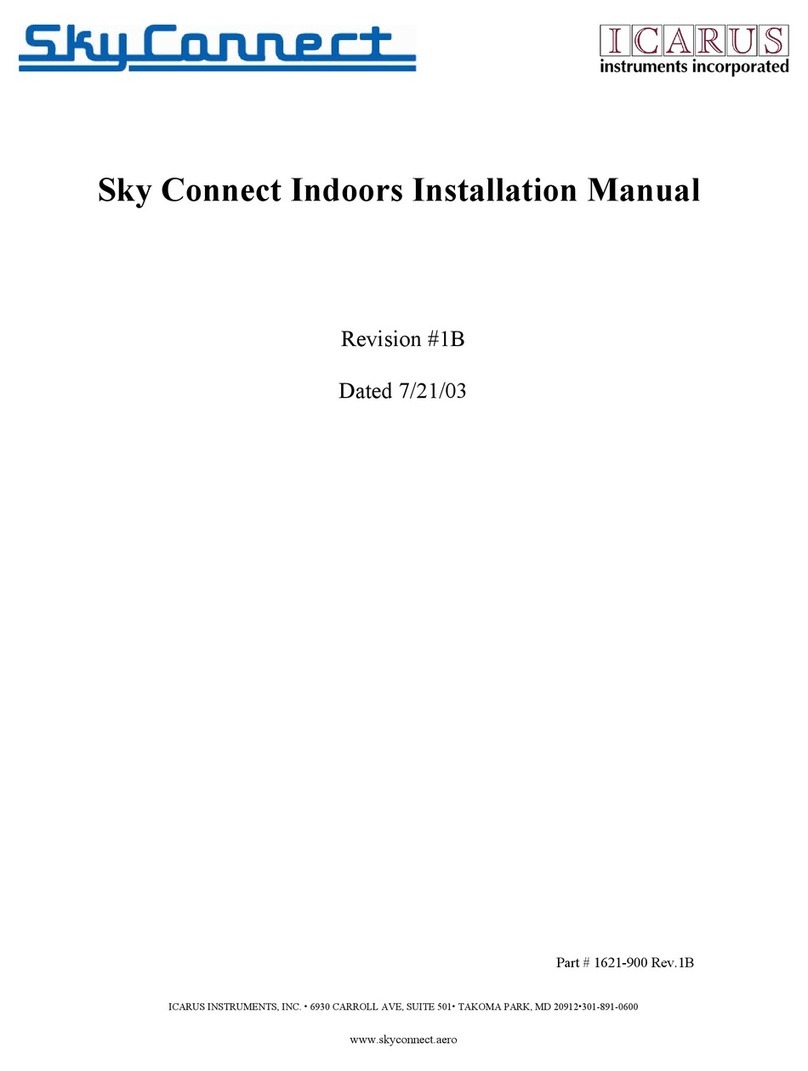
Icarus
Icarus Sky connect installation manual
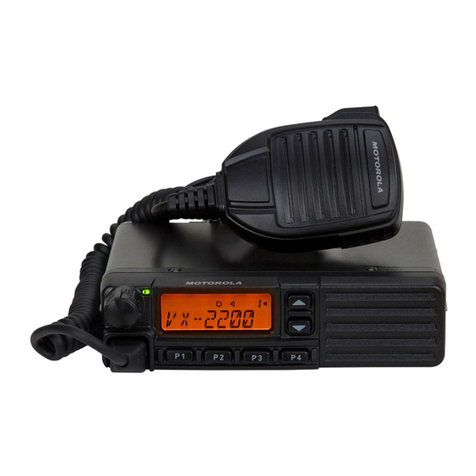
Vertex Standard
Vertex Standard VX-2200 Series Service manual
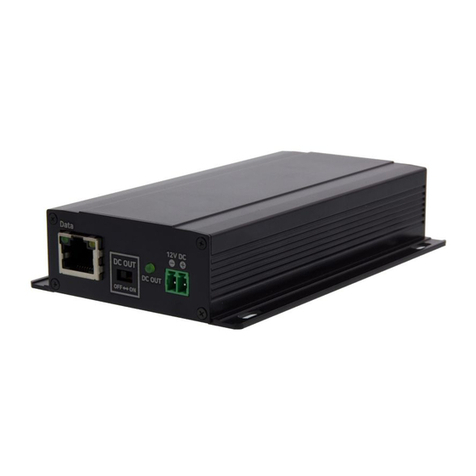
Eneo
Eneo IAM-6MC1001M0A Quick installation guide
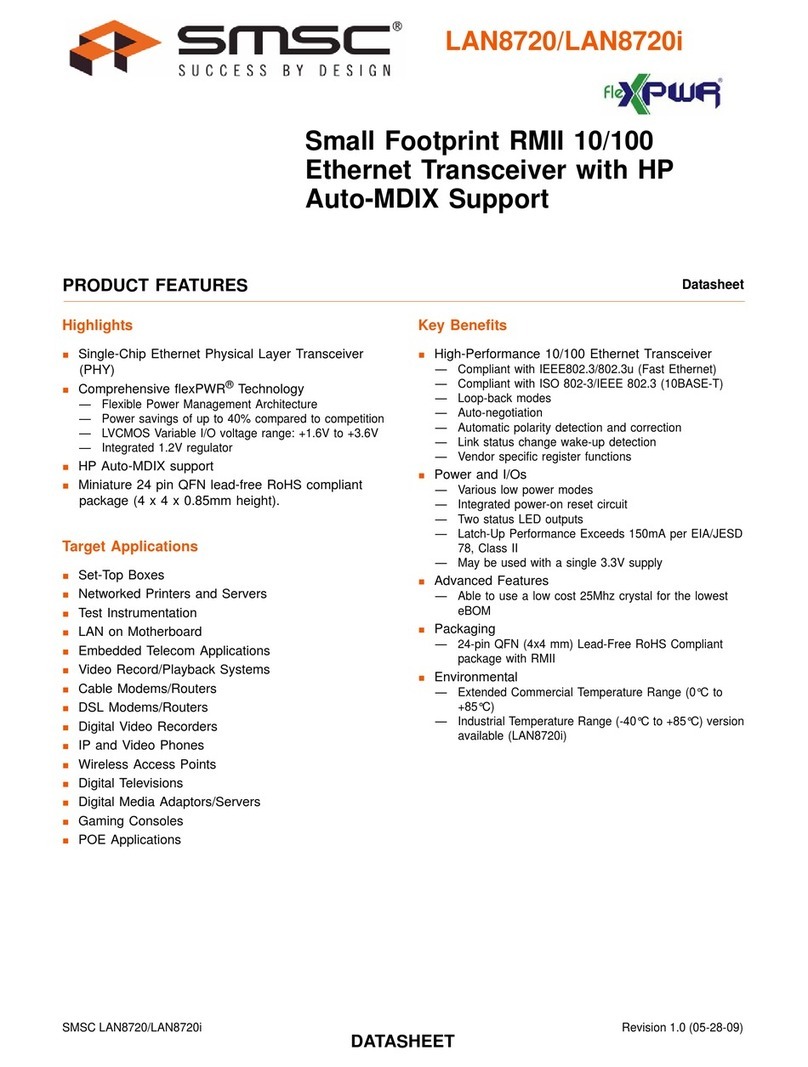
SMSC
SMSC FlexPWR LAN8720 Specification sheet

Red Pitaya
Red Pitaya HAMlab 80-10 10W user manual
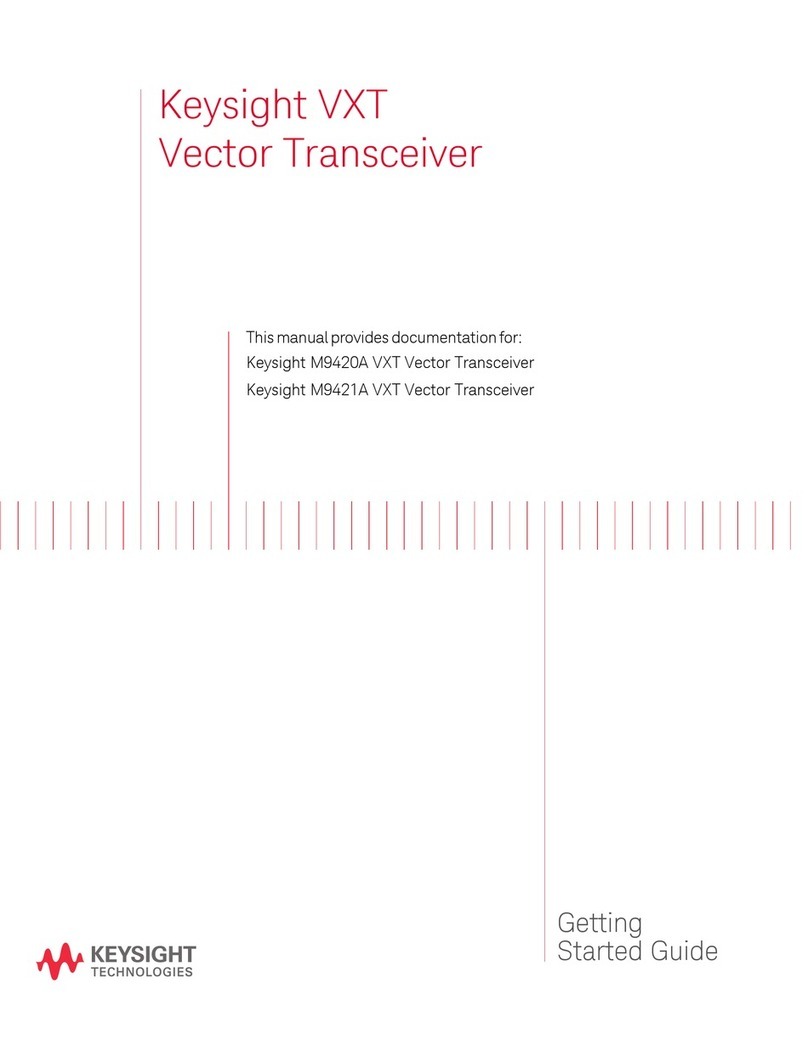
Keysight Technologies
Keysight Technologies M9420A Getting started guide
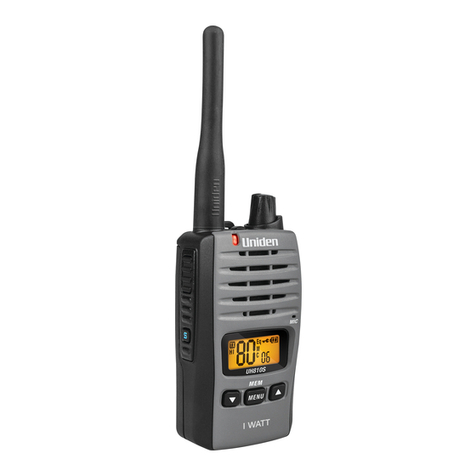
Uniden
Uniden UH810S owner's manual
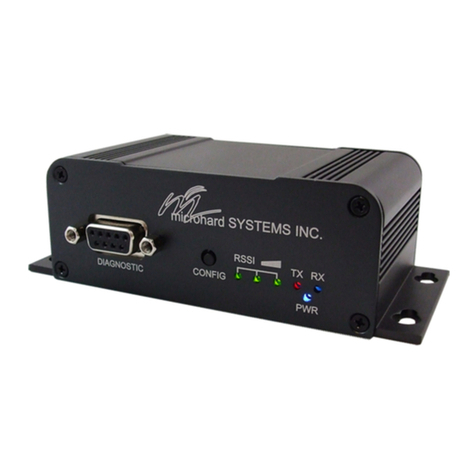
Microhard Systems
Microhard Systems n920BT operating manual
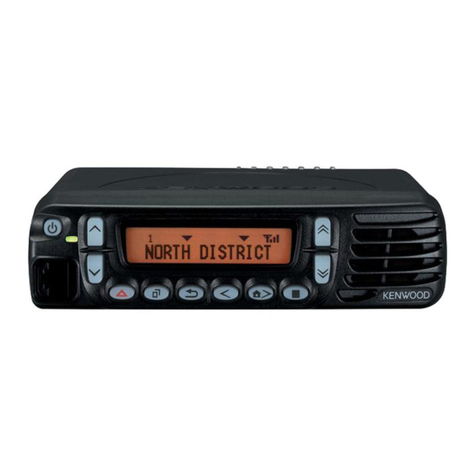
Kenwood
Kenwood NEXEDGE NX-700 series instruction manual
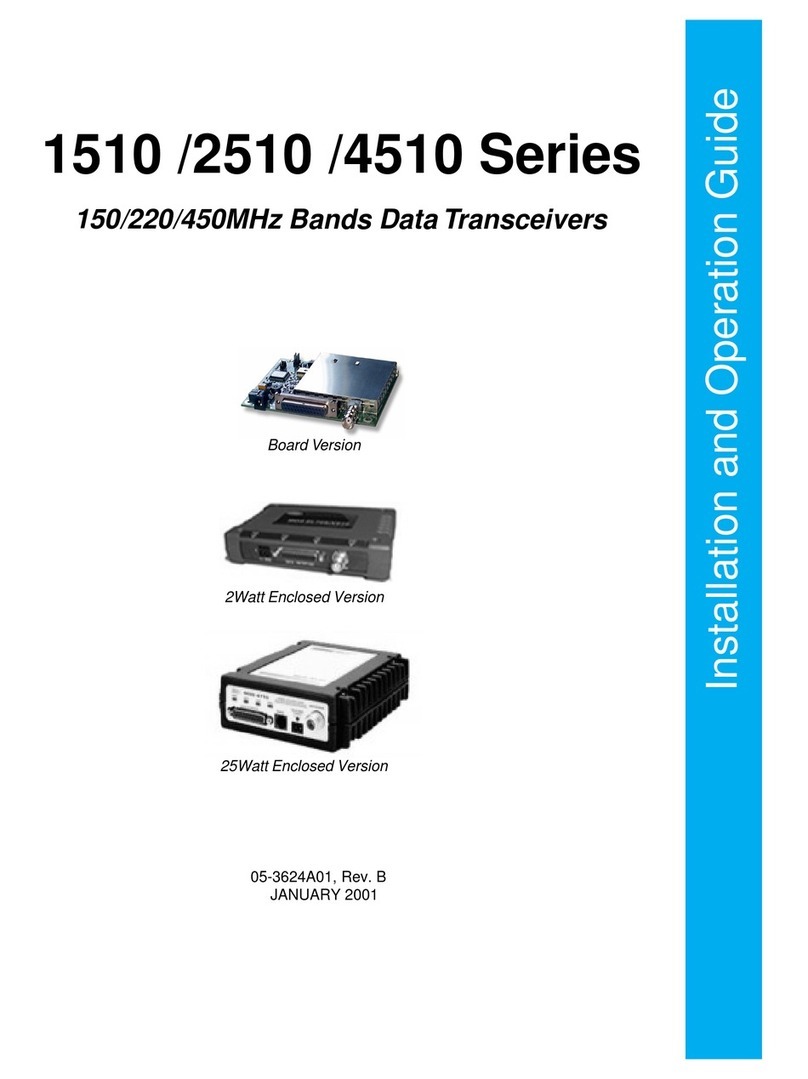
Sinosun
Sinosun 1510 Series Nstallation and operation guide

Standard Horizon
Standard Horizon HX290 owner's manual

West Marine
West Marine VHF 250 owner's manual

